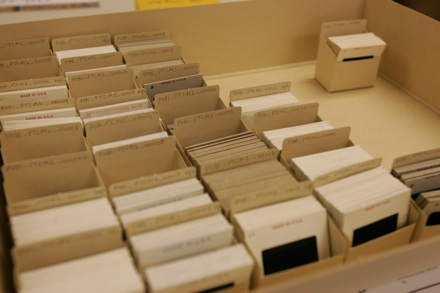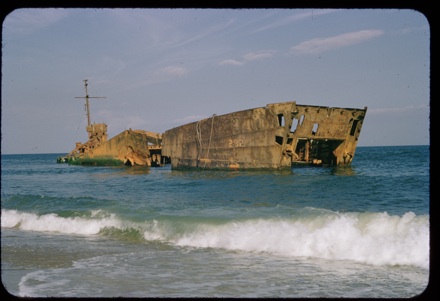Recently, I have started going through the piles of 35mm slides we have in storage. It is quite a process (however, these have been a little easier than the machine prints). Over three weeks I was able to process all 7,894 slides from the 1960s. I shouldn’t say all, though, because I’m sure we will find a random box someplace with more slides in it!
I quickly found that in organizing mounted slides, there is more information available to you than just the content of the image itself. Most slides since 1960 have a date (month and year) and a frame number stamped on the mount. Most also have an indicator of film type (e.g. Kodachrome, Ektachrome, Kodachrome II), and some have a letter-number code (W9, A5, A6, A1, R2, H3 etc. — if anyone know what these codes mean, please let me know!). Plus, the date stamps and film type names were printed in various colors (usually red or black). I can use all of these clues to help reassemble sets/rolls that were broken up for one reason or another.

In the beginning phases, I changed my strategy often. (Stephen had already sorted the slides by year shortly after they arrived, making my job considerably easier). Each box usually had a few slides that did not belong with the rest, and there were often big gaps in numbering. I started listing in a spreadsheet all the missing numbers from each set, noting the film type and the color of the date stamp, but by the time I started on 1965, I decided that making note of all the missing slides was not helping me. I wouldn’t trust the notes I had written and would check for the number sequence anyway.
Stephen also had many piles of slides he had found floating around loose that needed to be matched with their rolls. This meant looking at the loose slides on a light box and using my various labels and descriptions to find a home for each one.
I am now starting on the 1970s and am changing my strategy once again, because I have twice as many boxes of slides as I did for the 60s. Hugh must have really hit his slide stride in the 1980s — those boxes are falling off the shelves! I’m sure my strategies will change a few more times before I see the end of the sea of slides.



I wonder, do most photographers today make use of tools for adding metadata to their photos? I’ve seen one news photographer do it – he recorded a little voice memo with each snap, which his camera allowed him to do – but somehow I think we’re all still lax about recording the information when we take the photo. Maybe people use after-the-fact tools to update the internal (EXIF?) information?
Amber, here is a link that might offer some help as you work through the Morton slide collection.
http://www.historicphotoarchive.com/f2/kodachrome.html
The letter/number combinations are the Kodak lab where the film was processed (e.g. “W” = “Washington DC”) and the machine at the lab that did the processing (e.g. “2” = machine #2).
I’m digitizing ~5,000 slides mostly 1950s & 60s I inherited and am grateful for the ones that have the imprinted date and lab info. It makes finding the right home for all the wandering slides that much easier.